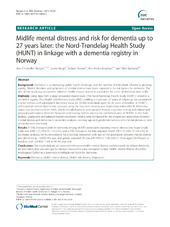| dc.description.abstract | Background Dementia is an increasing public health challenge, and the number of individuals affected is growing rapidly. Mental disorders and symptoms of mental distress have been reported to be risk factors for dementia. The aim of this study was to examine whether midlife mental distress is a predictor for onset of dementia later in life. Methods Using data from a large population-based study (The Nord-Trøndelag Health Study; HUNT1) linked to a dementia registry (The Health and Memory study; HMS) enabling a maximum 27 years of follow-up, we ascertained mental distress and subsequent dementia status for 30,902 individuals aged 30–60 years at baseline. In HUNT1, self-reported mental distress was assessed using the four-item Anxiety and Depression Index (ADI-4). Dementia status was ascertained from HMS, which included patient and caregiver history, cognitive testing and clinical and physical examinations from the hospitals and nursing homes serving the catchment area of HUNT1. In the main analysis, unadjusted and adjusted logistic regression models were computed for the prospective association between mental distress and dementia. In secondary analyses, two-way age and gender interactions with mental distress on later dementia were examined. Results A 50% increased odds for dementia among HUNT1-participants reporting mental distress was found (crude odds ratio (OR): 1.52; 95% CI 1.15–2.01), and a 35% increase in the fully adjusted model (OR 1.35; 95% CI 1.01-1.80). In secondary analyses, we found evidence for a two-way interaction with age on the association between mental distress and dementia (p = 0.030): the age- and gender adjusted OR was 2.44 (95% CI 1.18–5.05) in those aged 30–44 years at baseline, and 1.24 (0.91–1.69) in 45–60 year olds. Conclusions Our results indicate an association between midlife mental distress and increased risk of later dementia, an association that was stronger for distress measured in early compared to later midlife. Mental distress should be investigated further as a potentially modifiable risk factor for dementia. | en_US |

